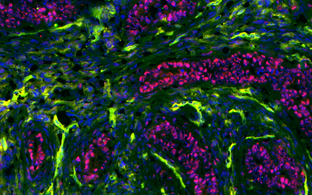
Blankenstein Lab
Molecular Immunology and Gene Therapy
Profile
- The development of cancer models that better resemble human cancer.
-
-
- The role of the tumor stroma for tumor progression and as target for immunotherapy.
-
-
- The development of strategies for convenient and effective T-cell therapy.
-
-
For clinical application, we employ T cell receptor (TCR) gene therapy. Therefore, we developed humanized TCRab gene loci/HLA trangenic mice that allow isolation of human TCRs against tumor-associated antigens from the non-tolerant repertoire. TCRs derived from these mice are restricted for self-MHC molecules and recognize the human self-antigen as foreign. Thus, T cells expressing such TCR resemble those that naturally protect us from pathogens; this is why we think they have an “optimal” affinity. A first clinical trial with a TCRs from thr humanized mice is in preparation.
Team
Research
Most of the current experimental cancer models do not reflect the pathophysiology of real-life cancer. Cancer usually occurs sporadically and is clonal in origin. Between tumor initiation and progression clinically unapparent pre-malignant cells may persist for years or decades in humans. More recently, mouse models of sporadic cancer have been developed. The mouse germ-line can be engineered with high precision so that defined genes can be switched on and off in the adult organism, ideally in a locally and timely controlled fashion. However, analysis of the immune response against sporadic tumors requires the knowledge of a tumor antigen.












